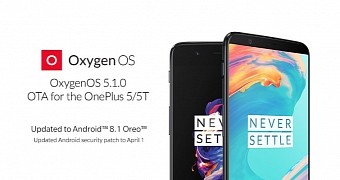Chinese smartphone manufacturer OnePlus released over the weekend the long-anticipated Android Oreo-based OxygenOS 5.1.0 software update for owners of OnePlus 5 and OnePlus 5T devices.
After being in beta testing during the past several months, OnePlus' OxygenOS 5.1.0 for OnePlus smartphones based on Google's Android 8.1 Oreo mobile operating system is now finally available for OnePlus 5 and OnePlus 5T devices, bringing the Android Security Patch for April 2018 and many other improvements and exciting features.
"For those who were on previous versions for OnePlus 5T, we appreciate your active feedback and attempts to reach out to us. With your help, we have been able to better optimize and improve several key areas. Thank you for your patience and, as always, we look forward to hearing your continued feedback," said OnePlus in the forum announcement.
What's new in OxygenOS 5.1.0 for OnePlus 5 and OnePlus 5T
Besides rebasing the base system on the most recent Android OS release, Android 8.1 Oreo, the OxygenOS 5.1.0 software update adds full-screen gesture support on OnePlus 5T devices, introduces category tags in application drawer's search section, along with the ability to automatically name folders based on the respective category.
The Gaming mode was improved as well as OnePlus added various new optimizations like power saving and the ability to pause adaptive brightness during gameplay. Additionally, a new network boost feature is now available in OxygenOS 5.1.0 to prioritize networks for games.
It also comes with all the new features and improvements of Android 8.1 Oreo, including a battery level indicator for connected Bluetooth devices, better detection of malicious URLs in Safe Browsing mode, and the ability to disable the fingerprint reader when multiple attempts or unregistered fingerprints are detected.
As expected, OnePlus is now rolling out the OxygenOS 5.1.0 software update to OnePlus 5 and OnePlus 5T users worldwide via OTA (Over-the-Air) updates. However, you should keep in mind that the rollout is, as always, incremental, which means that it would take a few days to arrive for all users.

 14 DAY TRIAL //
14 DAY TRIAL //